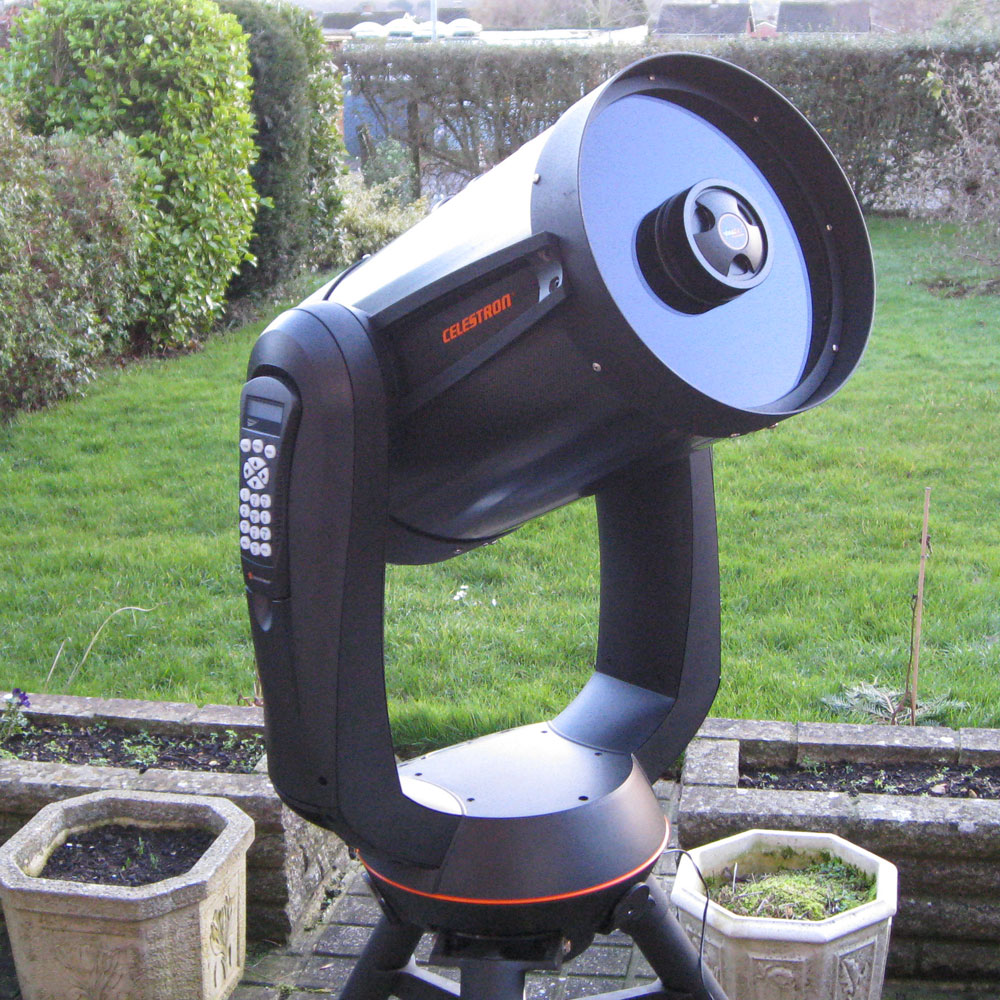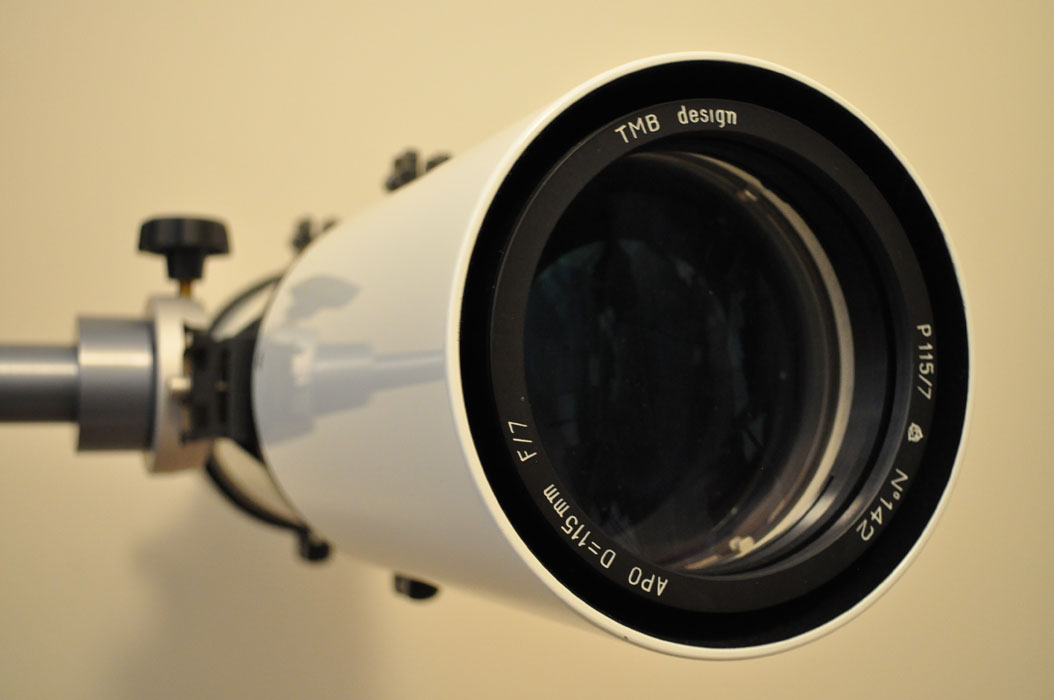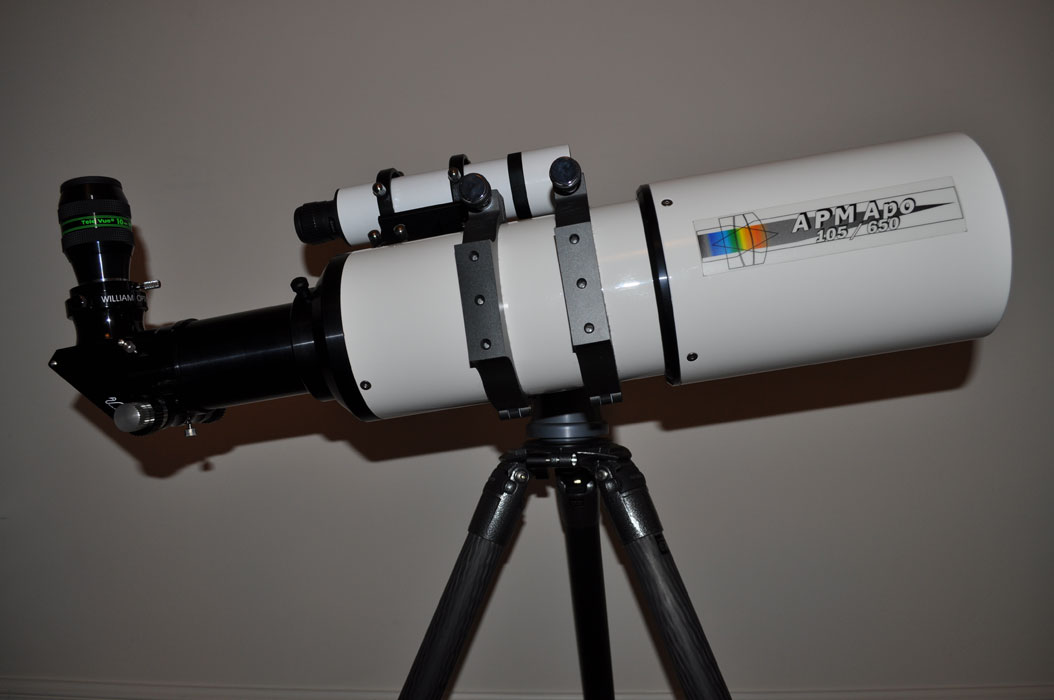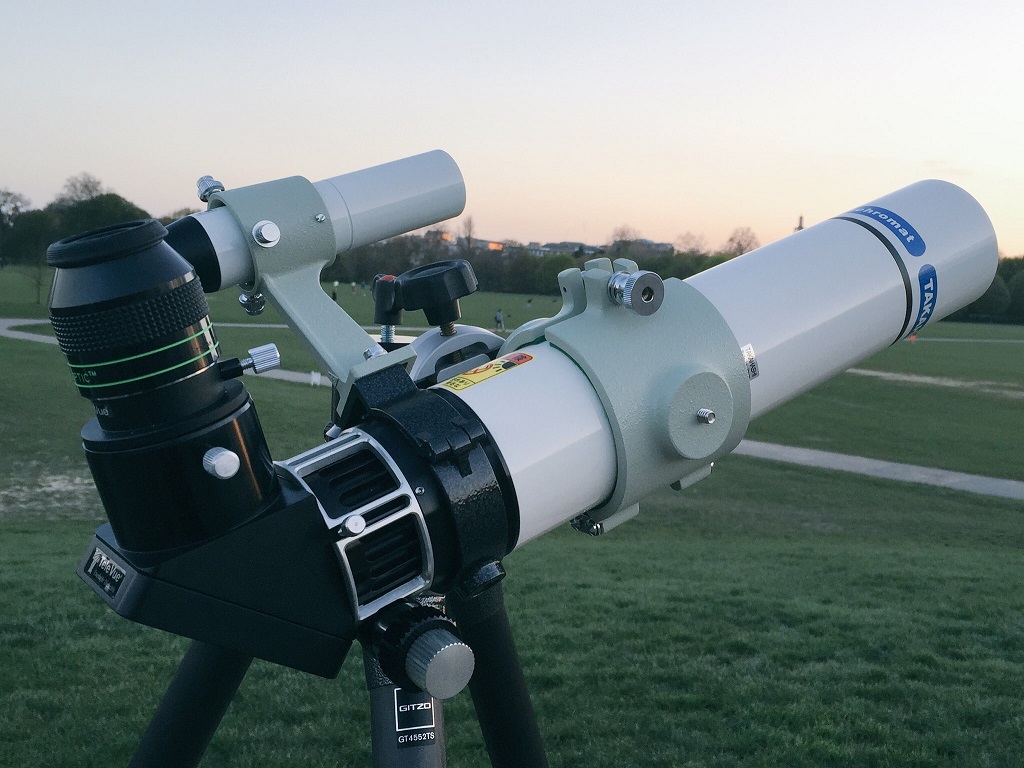The Celestron Nexstar 11 GPS
The Nexstar 11 GPS is the oldest scope currently in my possession and was purchased in 2002, less than a year after graduating. Having used one of the university’s Meade 10” LX200 Schmitt-Cassegrain telescopes for my Masters Photometry of T-Tauri Stars project I felt that a GoTo SCT offered the best balance of all the qualities I was looking for in a scope. Ease of use, combined with a large aperture in a compact package and GoTo electronics which means more time observing and less time searching seemed like a winning combination. However, extensive use of the LX200 had repeatedly demonstrated to me how loud the motors were when the scope was slewing around the sky. Concerns that the noise would disturb my neighbours led to Celestron which were reported to have far quieter motors. At that time Celestron had just launched its new Nexstar GPS series in 8”, 9.25” and 11” models. Sky & Telescope produced a glowing review and plenty more positive reviews were appearing on-line. This convinced me to go with the 11” model.
A fork mounted carbon fibre tube with 11” (280mm) aperture (3.75” central obstruction – 34%) and f/10 focal length (2,800mm) weighs in at 65lbs (29.5kg). Two well placed handles make carrying the fork/scope assembly easier that the 65lb weight would suggest. All metal gears (the newer CPC lowered the internals quality, such as replacing metal with plastic to reduce costs) and a clever internal slip ring which prevents cord wrap add to the overall quality. The scope benefits from GPS (at the time a very new innovation) which means it can auto-align though using magnetic north rather than true north can result in some pointing errors to the initial alignment stars depending on the local magnetic declination (difference between true and magnetic north) though this is eliminated after manual centring of the alignment stars as the scope then uses internal calculations for pointing. The Nexstar hand control has a database of thousands of deep sky objects and users can slew to any coordinates they desire. The power supply requirements are 12V DC and it can draw a hefty one amp so a heavy duty power supply is needed for extended observing sessions.
For anyone with an interest in astrophotgraphy, the secondary mirror can be removed and replaced with the Fastar / Hyperstar imaging system which sees the scope convert into a blazingly fast f/2 astrophotography system.
Many of those familiar with the venerable telescope companies Meade & Celestron consider the Nexstar series to be a product of Celestron’s golden age where both optical and mechanical quality were consistently high and my scope has proven to be a standout example over a decade of ownership.
The TMB 115/805 LW
Perhaps the best “small” scope I have ever used. I really love this one and definitely the telescope responsible for my obsession with high quality triplet refractors. In 2004 I decided I wanted a portable scope which I could take to dark sky locations in the UK, as my fork mounted Celestron Nexstar 11 GPS was just too heavy and bulky to easily transport. I had read a number of reviews of different TMB scopes, and having only used reflecting based scopes and lower quality achromatic refractors I decided I wanted to experience firsthand the minor revolution that was occurring in the amateur astronomy world at the time with the introduction of a number of very high quality 4” class triplet apochromatic refractors.
The scope has a 115mm aperture triplet apochromatic lens designed by the late Thomas M Back and manufactured by LZOS in Russia using their proprietary OK4 extra-low-dispersion glass for the centre element, an aluminium tube and a 2” Starlight Instruments Feathertouch focuser which allows 2” eyepieces to be used for a maximum visual field of 3.4o. The scope weighs 6.45kg (14.2lbs) with an observing length of 780mm (minimum transportation length of 627mm). Due to the implementation of sliding drawtube, the scope permits the use of any binoviewer and diagonal without any optical path correctors.
This scope offers essentially perfect chromatic and spherical correction presenting images of contrast and clarity that are rarely matched by any other scope I have ever used. It also amazes how much deeper the extra half inch of aperture allows this scope to go over 4” scopes. You can read the review of the 115 f/7 here.
The APM TMB 105/650 LW
In late 2011 I realised that I kept travelling to international dark sky locations, and found myself wishing I had some form of optical aid that would allow me to benefit from those skies. At the time I owned the Celestron Nexstar 11 GPS and the TMB 115 f/7. While the TMB scope was definitely portable, and had been chosen specifically as my dark sky transportable scope, the tube length was such that it could never be taken as carry-on luggage in an aircraft. Around the same time, I had booked my latest holiday, 2 weeks in Oman which would include stays in the middle of desert hundreds of kilometres from the nearest settlement. The chance to observe under some incredible dark skies (read about that experience here) was the motivation to purchase a third, airline portable scope. My experience with the TMB meant that I was well aware of the benefits of first class triplet apochromats in contrast and overall clarity of image, and while other designs were considered including small SCTs, in the end I selected the APM TMB 105 f/6.2. Knowing the quality of my TMB 115 and minimum requirements for each lens and the quality control employed, combined with the specific design of the scope to be airline portable saw me place an order and it was in my possession in early summer 2012.
The scope contains a triplet apochromatic lens fabricated by LZOS in Russia using an OK4 extra-low-dispersion centre element, with 105mm aperture and 650mm focal length (f/6.2), with a tube manufactured from Kruppax 50 and a 2” Starlight Instruments Feathertouch focuser which allows the use of 2” eyepieces for a maximum field of 4.2o. The scope weighs 6.0kg (13.2lbs) including tube rings, with a tube diameter of 135mm and minimum length for transportation of 17.3” (440mm), making it truly airline portable. The observing length is 24.01” (610mm) and is achieved via a sliding drawtube which retracts inside the tube on Teflon straps and secures with a locking screw which prevents any tilting. This sliding drawtube allows the use of any binoviewer with any diagonal without the need for any optical path correctors or Barlow.
The optical quality in this scope is phenomenal and truly remarkable given the fast f/6.2 focal ratio. Due to the quick set up, small size and weight, and overall quality, this scope has become my most used telescope since I purchased it and has proven itself on trips abroad delivering some of my most memorable stargazing experiences. You can read the review of the APM TMB 105 here.
APM LZOS 180/1260 LW II
So impressed with the clarity and contrast of the images produced by my two 4” class TMB triplet Apo scopes, I decided in late 2012 that I wanted to experience that quality in a far larger scope so I placed an order with APM for the 180mm f/7 LZOS manufactured triplet lens apochromatic refractor. Scopes of this size are made to order and final delivery took approximately 9 months from the initial order, but it was certainly worth the wait.
The aperture of the scope is 180mm (7.1”) with a long retractable dew-shield which does an incredible job of keeping dew off the lens. The focal length is 1,260mm which allows a maximum true field of 2.1o with 2” eyepieces. The telescope tube is made of Kruppax-50. On the back of the scope there is a 3.5” Starlight Instruments Feathertouch focuser which is a work of art. The scope transportation length is 1,100mm (1,350mm when observing) with a maximum tube diameter of 256mm. This is a very large, and front heavy scope, which weighs in at 23kg (49.8lbs).
A scope of this size and weight requires a rather substantial mount and I currently use it with the APM AzMaxLoad Alt-Az mount on a Losmandy G11 tripod. Assessing whether a mount will provide a stable platform for a particular scope is never as straight forward as looking at load capacity (in this case quoted at around 50kg per side) as moment of inertia is also a very important consideration. The 180 is long and front heavy but APM were confident that the mount would be up to the job and they were right.
Though I currently use the scope exclusively for visual, the APM 180/1260 is well suited for imaging. There are two dedicated imaging accessories available. The first is an optimised field flattener matched to the LZOS optics which is designed for sensors up to medium format size. Each flattener body is custom made for either CCD or 6×7 format use. The second is a Massimo Riccardi designed Reducer. This reduces the effective focal length to 945mm and focal ratio to a fast f/5.25. The reducer is a fully Apochromatic design using ED glass.

Left: Admiring the scope with Dr Chris North on the October 2013 Sky at Night (Credit:BBC). Right: the APM 180 ready to go at Astrocamp in the Brecon Beacons.
Takahashi FS-60CB and Takahashi FC-76 Objective Upgrade
Motivated by the desire to always be able to take some form of optical aid on trips, and the very limited baggage allowance for internal flights in Namibia for my two week stargazing trip in September 2014, I began considering an ultra-portable scope in the 60 to 80mm range for those times when even the APM TMB 105 is too much to carry. After much deliberation, I settled on the Takahashi FS-60 CB. The scope is an ultra portable 60mm aperture, f/5.9 doublet apo refractor with the front element made from fluorite. Weighing a little over 1kg, the scope is well supported by a light weight photo tripod. Due to the limited back focus available with the standard Takahashi focuser (the drawtube is only 1” long to prevent light cone cut off when the focuser is racked in for imaging), I have replaced the standard focuser with a 2” Starlight Instruments FTF2015BCR-LW light weight feathertouch. The focuser has the same load capacity as regular feathertouch 2” focuser of 8-10lbs but it weighs 0.298lbs less than the standard 1.122lbs. The scope has minimum length for transportation of only 10.8” (275mm) though a 2” extension tube is required to bring the scope to visual focus and the diameter is only 3.1” (80mm). You can read the review of the Takahashi FS-60 here.
It has to be said though that an aperture of 60mm will run out of light fairly quickly and mindful of this, I also decided to add the Takahashi FC-76 objective upgrade. By simply unscrewing the 60mm objective of the Tak 60, and replacing it with the 76mm objective, the scope becomes a 76mm f/7.5 fluorite doublet apo which is also extremely portable because the scope splits in two for transport. I now have two solutions which I can configure to each trip based on how much luggage space I have. In the configuration using the FC-76 objective the scope weighs just over 2kg (including clamshell) so still ably supported by a light weight photo tripod, with a tube diameter of only 80mm and length of 23.2″ (590mm) which includes the fixed dew shield and extension tube. You can read the review of the Takahashi FC-76 here.
The ability to use both 1.25” and 2” eyepieces was particularly attractive with max visual field with the Tak 60 and 76 of 7.4o and 4.6o respectively which is wonderful for sweeping the Milky Way under dark skies. I mount both of these scope configurations on a Gizto Systematic Series 4 GT4552TS Carbon fibre tripod and Gitzo head or Tele Optic Giro Mini. Combined weight of scope, tripod and head is for TAK 60 and FC-76 is 3.9kg and 5.0kg respectively.
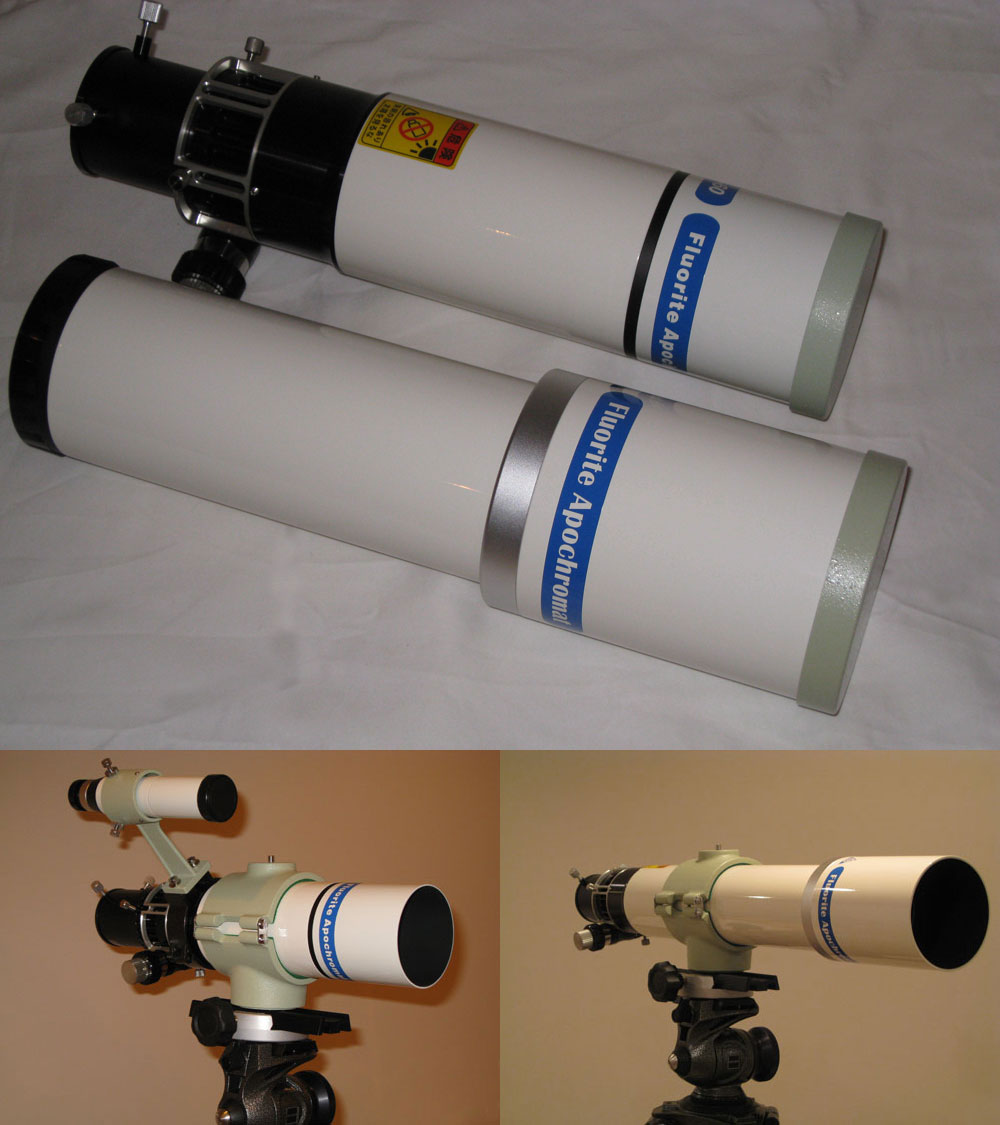
Top: The Takahashi FS-60CB and FC-76 Objective Upgrade. Bottom Left: The Tak 60. Bottom Right: The Tak 76.
Takahashi FS-60Q
I have been incredibly impressed with the little Takahashi FS-60 and quite surprised by how much a 6cm aperture can reveal of the night sky, especially from a dark site. That scope has now travelled multiple times to Africa as well as several destinations in Europe and the UK. The excellent optical quality and extreme contrast have left me a very satisfied owner. However, one target in particular is the FS-60s Achilles heel and that is Mars. Many fast doublets are better corrected at the blue end of the spectrum and can struggle with the ruddy browns and reds of Mars which can leave the image soft and underwhelming. The modular nature of the FS-60 is a feature that has always appealed and one component in particular looks to overcome that weakness, the 1.7x CQ module. Either sold as a complete scope, or as an accessory to easily retrofit to a standard FS-60, the module screws in behind the lens and converts the scope into an f/10 quadruplet super apo, the FS-60Q. Takashashi claim the module corrects for many aberrations inherent in the base FS-60 (especially off-axis) and some Japanese sites (using Google translate) claim the module improves the system strehl by as much as 10%. Unable to resist the temptation of having a small scope that really can do it all, I purchased the CQ module, giving me the best of all worlds with both a FS-60 and FS-60Q depending on where I am travelling and what I intend to observe. You can read the review of the Takahashi FS-60Q here.
APM LZOS 130/1200 Apo
My most recent telescope purchase came in 2018 and was one I had an eye since it launched back in 2005. Tom Back of TMB optical designed a 5” super planetary telescope as the successor to the then discontinued Astrophysics 130 f/8.35 EDT. For those that like numbers with their scopes, the design polychromatic strehl is 0.984 (meaning a perfectly executed example would have this level of measured strehl across the visual spectrum) and the longitudinal aberration plot showed that it has four widely spaced colour crossings (and almost 5) which makes it a super-achromat (5 is called a hyper-achromat). The only other production lens to have four crossings was the APOMAX f/12 back in the late 90s and one of those crossings was in the near-infrared so it had no impact on the visual performance of the scope. The lens is also better than 1/10 P-V wavefront from 450nm to 700nm which means it is getting close to being a Baker Super-Apochromat. That might not mean much to many who read this, but the quality of this scope is rather special among a whole offering of special telescopes. The transportation length is 106cm and weighs 11.3kg including handle and Losmandy D plate. So still quite transportable, but the length does require a pretty robust mounting solution to allow the scope to operate at the ridiculously high powers it is capable of. You can read the review of the APM TMB LZOS 130/1200 here.






